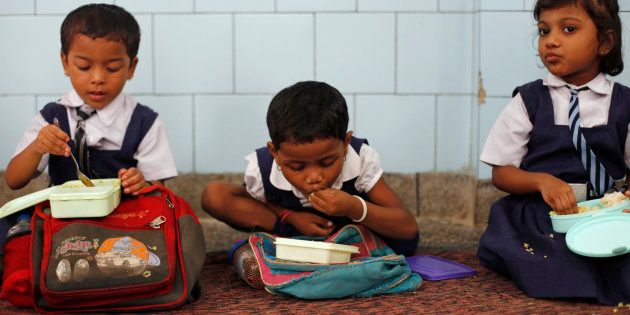
Two new studies are finally helping answer the question--did spending on social sectors like education and healthcare fall in the last two years?
When Finance Minister Arun Jaitley presented the budget in 2015 and 2016, the Narendra Modi government was criticised for making cuts in spending on key social sectors including health and education. At first glance, this seemed to be true.
(Caveats: the numbers are from the Finance Ministry's Indian Public Finance Statistics 2015-16 and so the 2014-15 and 2015-16 numbers are revised estimates and budget estimates respectively, and not actuals. The 2016-17 report is not yet out.)
But the Centre and states both spend on social sectors, and the major change is actually in the structure of funding; yes, the central government is spending less on social sectors, but it's putting more money in the hands of states, a process that began with the UPA's last budget, the 2014-15 interim budget. With the NDA government accepting the recommendations of the 14th Finance Commission in February 2015, the union government scaled back its direct spending on several key schemes and instead increased the share of central tax money that states would receive from 32% to 42%.
This, the government said, would give states more fiscal autonomy; the 'tied' funds they usually received as grants for specific schemes like the Sarva Shiksha Abhiyaan and the National Health Mission would be increasingly replaced with 'untied' funds--their share of central taxes that they could spend as they pleased.
The question then was: would states continue to spend on priority areas like health and education, or would they decide, instead, to spend on infrastructure or debt financing? This is where two new studies come in, which show that states have spent a similar if not bigger proportion of their new untied funds on social sectors, more than making up for the shortfall in central spending.
Researchers from the independent, non-partisan PRS Legislative Research travelled to 17 states and studied their 2016-17 budgets. In a report authored by Aravind Gayam and Vatsal Khullar, they found that states' expenditure on education (the #1 spending priority), health and rural development grew slightly in 2015-16 and 2016-17. Chhattisgarh and Maharashtra spent the largest shares on education among all states (19% of all expenditure), while Jammu & Kashmir and Kerala spent over 5% on health, PRS found.
A report by Delhi-based Accountability Initiative (AI) found similarly. Studying the budgets of 19 states, they found a substantial increase in social expenditure as a proportion of state spending. The highest increases were visible in many of the poorest states including Bihar, Chhattisgarh and Jharkhand while Telangana nearly doubled its social sector expenditure. For the few states where Gross State Domestic Product (GSDP) figures were available, social sector spending as a proportion grew.
More social sector spending could mean good politics for states. "For poor states, social sector spending is their bread and butter," Shaibal Gupta, founder member secretary of the Patna-based Asian Development Research Institute. "In Bihar's case, we have not benefitted substantially from the 14th Finance Commission, but the state has been growing at a fast pace for the last ten years and spending a growing proportion on the social sector," he said. Cuts in central schemes have affected the state substantially, however, Gupta said.
So has this increase in state funding made up for the fall in central funds? This is probably the case based on preliminary data.
That social sector spending would not fall was expected, but it may be too early to reach conclusions, Bibek Debroy, NITI Aayog member, said. "The entire pattern of public expenditure in the country is going through a major overhaul," he said. One factor is the changes emanating from the 14th Finance Commission. The second, Debroy said, was from the Sub-group of Chief Ministers on the rationalisation of Centrally Sponsored Schemes, the abolition of the plan/ non-plan distinction and a shift towards reporting tangible results as opposed to spending numbers alone. "State governments are also in a period of transition, and this takes time. We are still in the midst of this transition, so in some senses any analysis is premature; we might not see stable patterns emerge until 2017-18," Debroy said.
There are a number of other caveats to the numbers. For one, 2015-16 numbers are revised estimates and the 2016-17 numbers budget estimates, so we don't yet know what the actual spending for these years was. Then, 2014-15 was an unusual year as spending was depressed overall, says Yamini Aiyar, director of AI. Additionally, states now have to pay a fixed 40 per cent of all Centrally Sponsored Schemes (while the ratio used to vary earlier), which might undermine flexibility, Ms. Aiyar says. A large looming question mark is the potential impact of the Seventh Pay Commission on state finances. "Going forward one of the big questions is going to be: what does Seventh Pay Commission do to non-wage expenditure in social sectors," Ms. Aiyar said. The Commission recommended a 23 per cent increase in central government employees' pay, benefits and pensions.
Additionally, AI noted that the UDAY Scheme - which required states to bring into their budgets 50% of the outstanding debt of power distribution companies in 2015-16 and finance this by means of special power bonds - would come at the cost of social expenditure. The impact of this scheme was not factored into the analysis.
Also On HuffPost India:
